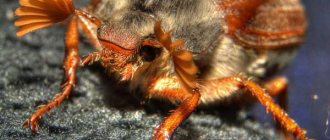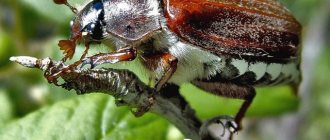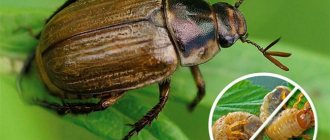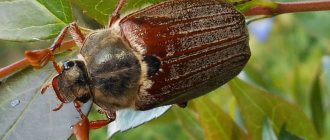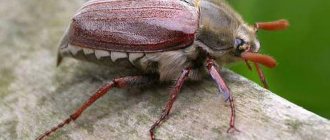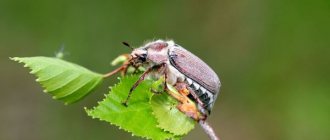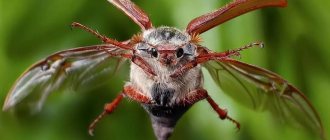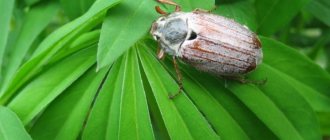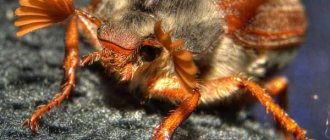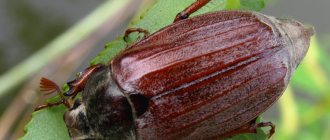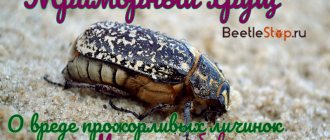The chafer beetle belongs to the subfamily of beetles (Melolonthinae). All representatives of the subfamily are plant pests, as their larvae eat living roots. For all species, summer begins in the last month of spring (November in the southern hemisphere), so any beetle from the beetle subfamily can be called a May beetle.
On a note!
There are 10 tribes in the subfamily, but only 2 of them are of interest to gardeners in the former USSR: flower beetles (Hopliini) and chafers (Melolontha).
What does a cockchafer look like?
May beetles are the insects that most closely correspond to the generally accepted idea of beetles. The tribe includes 20 genera. All cockchafers are similar to each other, differing only in small details of body structure and coloring.
Sometimes, due to the color, the beetle, which belongs to the cockchafer tribe, is difficult to recognize. This one especially belongs to the genus of marbled beetles with the Latin name Polyphylla. Photos and descriptions of the cockchafer usually give an idea of another genus - Melolontha.
Genus Melolontha
Representatives of the genus have large body sizes, which can reach 32 mm. The body of the beetle is convex, oblong-oval. The color is black or red-brown. The elytra are usually yellow-brown or red-brown. There may be a faint greenish tint to the head. The body is covered with fine punctures and fine light bristles. Legs are short or moderate in length.
Antennae with 10 segments. 3rd segment elongated. The male has a “club” of 7 plates at the end of the antennae.
The elytra are ribbed and elongated oval. The chest is covered with thick and long yellow stubble. The posterior end of the abdomen is triangular in shape, large, and inclined towards the ground.
On a note!
You can distinguish a female cockchafer from a male by the posterior tip of its abdomen. The tip of the male's abdomen is pointed and longer than that of the female. The male's abdomen itself also protrudes more from under the elytra than that of the female.
Chafer
Genus Polyphylla
Khrushchi with a body size of 3-4 cm. The body of females is always more massive than that of males, and the legs are shorter. The body is massive, convex, long. Body color is black, black-red or black-brown.
The back of cockchafers is covered with light scales, which sometimes completely hide the main color. The scales may be grouped into spots or a specific pattern.
The eyes of marbled beetles are convex and large. On the antennae of males, the club consists of 7 plates, in females - of 5. The elytra are without ribs, with rounded sides. The legs are thin and short.
Planting lupine for preventive purposes
Lupine is an excellent green manure that improves the quality characteristics of the soil, promotes its aeration, saturates it with nitrogen and prevents the growth of weeds. And since there will be no weeds in the plot where it is planted, the larvae will not get anything for “lunch” except the roots of the lupine itself, which for them is pure poison!
People's advice often mentions bleach, which actually works against the beetle, but the priority should always be the feasibility of one method or another, and in the case of chlorine it is questionable. Many gardening crops do not tolerate such “feeding” well, which is why in agricultural technology there are restrictions on the addition of even beneficial potassium chloride. But mulching the soil during crop growth and sowing green manure after harvesting will benefit fruiting, make the farmer’s work easier, and an excellent preventive measure against pest beetles.
External structure
Khrushchi are no different from other representatives of Coleoptera. Therefore, the structure of cockchafers is similar to other insects from this order:
- the head, on which the eyes, antennae and mouthparts are located;
- thoracic region of 3 segments, a pair of legs is attached to each segment;
- abdomen of 8 segments.
All functions of insect movement are performed by the thoracic region. There are 3 pairs of legs attached to it below, and 2 pairs of wings on top.
Interesting!
The rigid elytra are actually a modified first pair of wings. The real pair of cockchafer wings is quite small and has difficulty lifting its host into the air. The flight occurs with a low humming sound. Raised elytra do not add aerodynamics to the cockchafer. The flight is clumsy and the speed is low. Therefore, myths about the accumulation of electricity by the cockchafer in flight did not arise. Since the cockchafer flies poorly, it rises into the air to find a pair for mating or to fly to the nearest tasty plant.
Internal structure
The internal life support systems of the cockchafer include:
- digestive system;
- respiratory system;
- excretory system;
- reproductive organs;
- primitive circulatory system;
- primitive nervous system.
The structure of the May beetle
The circulatory system consists only of a dorsal vessel, passing along the central axis of the beetle and “suspended” to the upper part of the chitinous skeleton. 3 primitive hearts are located in the abdomen of the insect.
The central nervous system includes:
- the brain, consisting of two nodes of the suprapharyngeal ganglion;
- peripharyngeal connectives;
- ventral nerve cord.
The first two nodes are in the head, the rest in the torso.
The digestive system consists of the foregut, midgut and hindgut. In the first two sections, the insect assimilates food, the last is responsible for excrement and water exchange.
On a note!
The respiratory system consists of 18 tracheae, the spiracles of which extend to the lower parts of the chest and abdomen. A large number of spiracles provide the cockchafer with good air exchange when it burrows into the ground or is in flight.
The female reproductive system includes:
- 2 ovaries;
- 2 oviducts;
- 1 “external” oviduct, through which the eggs enter the external environment;
- spermatheca;
- accessory sex glands.
The male has:
- 2 testes;
- 2 seed tubes;
- vas deferens;
- copulatory organ;
- accessory sex glands.
Chemical methods of pest control
The use of heavy insecticides should be avoided. Together with the pest, they will also destroy beneficial insects, for example, bees, without which the reproduction of flowering plants is almost impossible, and will also scare off its natural enemies - birds, amphibians and predatory insects. You can protect the area from the invasion of the cockchafer in the following ways: mulching the soil with crushed tree bark, chopped straw or wood shavings and sawdust, which makes it difficult for the insect to penetrate the soil to lay eggs; Mulching the soil with straw aromatically repels the pest - it does not tolerate the smells of elderberry, lupine, representatives of the cruciferous family, turnips, mustard, wormwood, turnips, etc.
"Bazudin"
Made in Switzerland. The active ingredient is diazinon, which requires careful use and compliance with safety measures.
In addition to beetle larvae, Bazudin is also effective against wireworms and some other harmful insects. It has Russian analogues, these are “Grom”, “Kapkan” and “Dohloks”.
Carefully! “Bazudin” is a dangerous substance for fish and other inhabitants of water bodies, so it should not be allowed to get into ponds and rivers!
"Zemlin" and "Pochin"
They also work against several groups of insects that cause damage to crops. To get rid of the “May” offspring, sawdust or dry sand is poured into a 0.5 liter jar, after which you need to add one package of the product and mix the contents well. Used when transplanting seedlings to protect them. Add 1 tsp to each planting hole. the resulting composition.
"Aktofit"
It is an insectoacaricide with contact effects on the digestive system. It works due to natural inhibitory toxins with a specific focus. Once in the insect’s body, it affects its nervous system and causes death.
"Antikhrushch"
Made in Ukraine. Insectoacaricide, which is a systemic 2-component contact disinfectant. Effective against several types of insects that damage crops. Like Actofit, it blocks the functioning of the nervous system, causing the death of individuals at all stages of formation.
Lifestyle and development
May beetles emerge from the ground at the end of May (hence the name) - beginning of June. The first thing the imago does when it comes out into the world is look for a mate. Insects mate in the first days of summer.
Khrushchev is an insect that has a full type of development. During its life, the cockchafer goes through 4 stages of development:
- egg;
- larva;
- chrysalis;
- imago.
After fertilization, the female cockchafer burrows into the ground and lays eggs there. The process of turning an egg into an adult takes 3-5 years.
The eggs of the cockchafer are oval in shape and size 2x2.5 mm. The female lays them at a depth of 20-30 cm. In just 3-4 times she can lay up to 70 eggs.
The development of the cockchafer takes place entirely underground. After 1-1.5 months, larvae emerge from the laid eggs and burrow to a depth of 50 cm. What chafers eat depends on the stage of development. The larvae feed on plant roots. They are not picky about food and eat everything they can find. During development, young animals go through 4 phases. After the end of the last, the larva burrows deeper and pupates.
Reproduction cycle of the cockchafer
The cockchafer pupa completes its transformation in the “cradle” at a depth of 40-50 cm. Its shape is similar to that of an adult, but it has a head tucked under the chest and short wings. The color of the pupa is yellow-white. The pupal phase lasts 0.5-1 month.
Interesting!
Pupation begins in mid to late summer and the cockchafer emerges from the pupa in the fall. It will come to the surface only in the spring. Because of this, it is difficult to say how long the cockchafer lives. If we take into account the full life cycle, the lifespan can be up to 5.5 years. The lifespan of an imago is no more than a year, taking into account the “underground time”. Khrushchev live on the surface for no more than 3 months.
What does it eat?
What do cockchafers eat? The larvae eat various roots , and the adults eat foliage .
Is the cockchafer a predator or not? Despite its impressive size, exceeding most other insects, the cockchafer poses no danger to them at all, eating exclusively plant foods .
May beetle pupa - photo:
Species of chafers of the genus Melolontha
Representatives of this genus live in Russia:
- Western May Khrushchev;
- Eastern May Khrushchev;
- Transcaucasian May Khrushchev.
They have a similar lifestyle, but their appearance is slightly different.
Western May
The insect has 2 names: Western May beetle and Western May beetle. Body length is 2.3-3.2 cm. It differs from other beetles in its high color variability. The most common variant: dark pronotum and yellow-brown elytra, abundantly overgrown with light bristles. The beetle gives the impression of being dusted with flour.
The insect is early: in the southern regions the beginning of summer occurs in mid-April. Among garden plants they prefer plum.
Habitat: most of Europe. In the north, May beetles are found all the way to the Moscow region. The southern one is limited to the Black Sea.
Eastern May
This insect is also called the eastern chafer or wild chestnut beetle. Eastern and Western Khrushchi are very similar, but differ in coloration elements and some other characteristics:
- smaller sizes (2.0-2.9 cm);
- medium sized eyes;
- the antennal club of the male consists of 7 segments, of the female - of 6, the plates of the male are 2 times larger than those of the female;
- the posterior end of the abdomen is very vertical.
The coloration of this species is very variable.
Range: all of Eurasia. The northern border runs through Arkhangelsk and Yakutia. Southern - through Odessa, Zaporozhye, Uralsk and Altai up to Shanghai.
May beetles of the genus Melolontha
Transcaucasian May
Length 2-3 cm. The color of the abdomen, head and pronotum is black. The elytra are yellow-brown and shiny. The larva is no different from the Western and Eastern Khrushchev. Range: Southern Europe and the Caucasus.
Species of the genus Polyphylla
Of the representatives of this genus, 3 species live on the territory of Russia:
- white;
- marble;
- Caucasian marble;
In this genus of May beetles, the main color is often hidden by scales that cover the body of the beetle.
White Khrushchev
Size 2.5-3.5 cm. It would be very similar to the western cockchafer, if not for the white scales densely covering the body. The male's main brown background is completely hidden.
The species is Central Asian, actively penetrating the European part of Russia. Already widespread in Crimea in the Evpatoria region. Lives in sandy soil.
Marble Khrushchev
Other names: motley Khrushchev or July Khrushchev. Adults emerge in July, hence the second name. The size of the cockchafer is 2.5-4 cm. The color is dark brown. On the elytra there are light spots formed by bristles. This characteristic pattern gave the insect its name. For life it chooses sandy soils.
Range: almost all of Europe. In Russia, the northern border runs through the Kursk, Voronezh, and Penza regions. Southern - along the coast of the Black and Azov Seas up to Anapa.
Caucasian marble
A large beetle 3-3.8 cm long and 14-19 mm wide. Color black/brownish-black. The dorsal part has a white pattern of scales. They live in dense soil. During the day they hide in the ground, at night they lead an active lifestyle.
Distributed in Central and Asia Minor, Greece and Transcaucasia.
Species of the genus Polyphylla
flowers
Heat-loving cockchafers that do not travel far to the north. In the CIS, their range extends across Belarus, Ukraine and the southern regions of Russia. There are varieties:
- large flower flower (Hoplia philanthus);
- small flower flower (Hoplia parvula);
- golden hoplia (Hoplia aureola);
Like all beetles, adult flower beetles damage the above-ground parts of plants. The larvae feed on living roots.
Large flower bloom
A medium-sized beetle, black or black-brown in color. The color of the elytra varies from dark to red-brown. The color of the elytra can also be dark with a red-brown border. On the upper side of the body the main color is partially covered by gray scales. The 10-membered antennae are black-brown. The body is slightly convex, oblong. Length 7-9 mm.
The range includes the territory of the entire European part of Eurasia. Summer begins in May. The lifespan of the imago is no more than 3 months. The general life cycle is 1 year. The females die after laying their eggs, and the larvae go to winter. Beetles are active during the daytime.
Lesser flowerflower
A small green beetle up to 1 cm in size. In fact, the color of the small flower beetle is black, but the body is covered with matte or shiny scales of green, golden-green, blue-green or brown.
On a note!
Sometimes green scales can be mixed with brown ones. Because of this feature, the beetle can easily be confused with a young bronze beetle or mint leaf beetle. But light hairs on the pronotum, sticking out between the scales, help to distinguish insects. They give the impression of a white coating. The underside of the body is covered with silvery-white scales.
The range includes Eastern Europe and reaches the middle reaches of the Urals. Absent in the Caucasus and Crimea.
Summers from late May to September. Active during the day, feeding on leaves. The larvae of this species do not have eyes. Beetles are found in large numbers on sandy soils. The life cycle is annual. The larvae go to winter.
flowers
Golden hoplia
A small beetle measuring 7-8 mm. The color is black, but the beetle is covered with yellowish-green scales with a spotted pattern. Black and brown spots. Females are larger than males. They don't fly well. The maximum distance is 200 m. The summer begins at the end of May and ends in August. The bulk of beetles emerge in June–July. Habitat: meadows. Settles in sandy and sandy loam soils. The range of golden hoplia is Eastern Siberia.
The rest of the hopliyas live outside the territory of the CIS and are not of particular interest.
Nutrition
The cockchafer causes great damage to deciduous and mixed forests, fruit and berry crops. It feeds on leaves, flowers, and damages ovaries.
His favorite delicacies are plum, apple, cherry, hazelnut and walnut; he loves oak and birch. The foliage of shrubs also serves as food for the beetle, and pine needles are also suitable for the eastern species. It eats everything suitable for food in one area, then flies to another.
Nurseries especially suffer from beetle infestations, as they can completely gnaw away young seedlings. The only plants that the insect does not eat are lilac and ash.
The larvae damage the roots of young trees, cereals and vegetables, causing the plants to die. These nasty-looking, translucent worms (popularly called “chrobak” or “furrowworm”) are well known to gardeners. If measures are not taken against them in time, they can destroy all seedlings.
